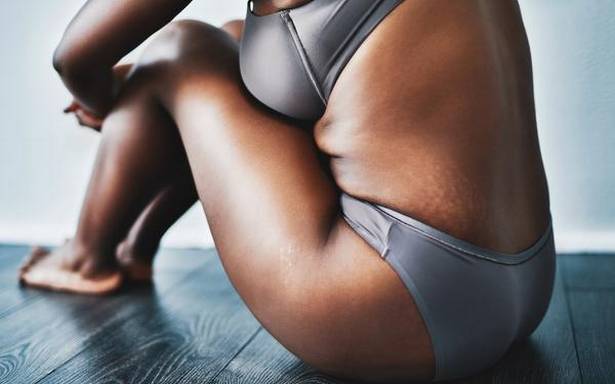The conversation around stretch marks is changing; we speak with social media mavens about how and why
Having gone through many weight fluctuations in her life, Tamil Brynta Ponn, who lives in Toronto, Canada, is no stranger to stretch marks.
“Stretch marks have become so common to me that I forget that they still aren’t completely accepted by everyone else,” she says in an Instagram post the plus-size model well-known on Instagram for her self-love posts about curvy bodies, stretch marks, and cellulite.
Influencer Brynta Ponn’s Instagram post for her stretch marks | Photo Credit: Brynta Ponn / Instagram
“As a society we’ve created a culture that has normalised the shaming and (painful) removal of something that honestly just makes you a normal human being. I always say, ‘stretch marks are normal; let your body grow in peace’,” says Brynta.
Stretch marks are seeing a renewed celebration on social media. Posts marked with #StretchMarksAreBeautiful now outnumber those of #StretchMarksBeGone and #StretchMarksRemoval. Actors Jameela Jamil, Malaika Arora and Rytasha Rathore have been vocal about embracing them as a natural part of the body.
Read More | Interview with Jameela Jamil on her ‘I Weigh’ movement
Closer home
Ponn wants more photographers to also showcase the natural states of human bodies; only then will the conversation flow from social media to mainstream offline spaces.
By definition…
- Medically speaking, ‘stretch marks’ are a type of scarring that develops when the skin stretches or shrinks quickly. This typically happens during puberty, pregnancy as well as weight loss and gain. The skin has three layers: the hypodermis (deepest layer), the dermis (the middle layer), and the epidermis (outer layer). Stretch marks are formed in the dermis.
- As your body grows naturally, the connective fibres in the dermis cause the collagen and elastin (which make up much of our skin’s structure) to rupture; so as the skin heals, stretch marks may appear.
Photographer Anushka Kelkar, who runs the inclusivity-friendly Instagram account BrownGirlGazin, has always noticed a disconnect between how she saw women around her and how they were presented in the media. The 23-year-old made it her mission to turn an honest lens on the beauty of south Asian bodies, and much of this was to capture them as they are. As a photographer in this space, her subject has to see her empathy.
But, it took us a long way to get here, and there is still more to do.
Recently, Khloé Kardashian made headlines when her grandmother posted an unedited photograph of her in a bikini. The Kardashian-Jenners received quite a bit of backlash when their legal team tried to get the since deleted image taken down from all corners of the Internet. Kardashian responded to the negativity with a series of text posts describing her trauma around body image. This sprung the #DearKhloe movement on Instagram, a series of posts from other women posting unedited images of themselves in swimwear. This movement on Instagram has served as an open letter to all women dealing with pressure to look perfect all the time.
Dermatologists are constantly being asked about red lasers and blue lasers to zap these stripes away, a majority of the requests coming from brides before their weddings. Dermatologists believe there is nothing wrong with the body or skin when stretch marks occur; they are actually a remarkable evolutionary trait we have to accommodate growth. These procedures are purely elective, and, yes, there is still a demand for them.
Read More | Our podcast recommendations on all things body positivity
In a 2019 blog post ‘Wearing a bikini when you have stretch marks’, travel blogger Arunima Dey — aka Namaste, Solo Travel — recalls how a series of toxic relationships, popular culture and social media informed how she looked at her own body. She eventually reshaped how she perceived herself and writes, “The Internet is abundant with articles on how to conceal your stretch marks and tummy fat. They make it sound like having stretch marks is a terrible thing. It isn’t, they are a part of what makes us, us. I am not about flaunting them but I am not about hiding them.”
Dolly Singh embraces her stretch marks in a yoga post on Instagram | Photo Credit: Dolly Singh / Instagram
Arunima’s ideas reflect the growing movement towards body neutrality — where the focus is on what your body can do for you, rather than what it looks like.
When Mumbai-based content producer and yoga practitioner Dolly Singh feels she has gained a bit of weight or muscle through her daily practices and asanas, she looks upon her body, sees a new stretch mark, and breaks into a smile.
She comments, “I feel it is a generational thing, since we have access to the Internet and the vanity of social media. My parents never disliked stretch marks and I see my nieces, who are more engaged with positive dialogues, are not of the mindset that they are anything out of the ordinary,” she explains.
Source: Read Full Article


